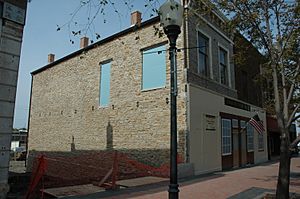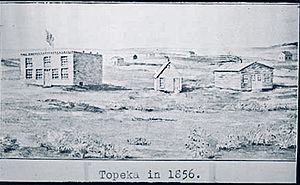Constitution Hall (Topeka, Kansas) facts for kids
Constitution Hall, in Topeka, Kansas, is one of the most famous surviving buildings of early Kansas. It is a two-story building of native limestone with a flat roof, constructed by brothers Loring and John Farnsworth between April and October 1855; at the time, it was at the center of the city. On October 23, 1855, free-state settlers, opposed to allowing slavery in Kansas Territory, met in what became the Topeka Constitutional Convention, which opened October 23, 1855.
Almost forty delegates, all of whom opposed the pro-slavery Southern element in Kansas, met. At the time, the Southerners, through a fraudulent election, controlled the legal government of the territory, which committed many illegal acts. The element controlled by the Northern immigrants into Kansas established their own government, which had no legal standing.
The convention produced what became known as the Topeka Constitution; under it, Kansas would have come into the Union as a free state. The United States House of Representatives voted for Kansas's admission in July 1856, but it failed in the Southern-dominated Senate by two votes. Parts were incorporated into the Constitution of Kansas (the Wyandotte Constitution) drafted in 1859.
Constitution Hall became the meeting place of the Northern element's government and legislature. This legislature drew the wrath of the Southerners in Congress, who asked President Franklin Pierce, a Northerner, to intervene. In July 1856, Pierce dispatched federal troops, led by Col. Edwin V. Sumner, to disperse the Topeka legislature. The troops arrived at Constitution Hall on July 4. Facing soldiers with rifles, bayonets, and a cannon, the members of the Topeka Legislature were forced to disperse.
The government of the Northern element continued to meet at Constitution Hall, sometimes storing supplies seized in Southern communities in the basement of the building. By the early 1860s abutting buildings were constructed to the north and south of Constitution Hall, making it part of a contiguous row of buildings. When Kansas became a state in 1861, Topeka became the capital.
Capitol of Kansas, 1863-1869
The new government planned a permanent capitol building but constructed a temporary facility in 1863 by remodeling Constitution Hall and some of the adjacent structures to create what became known as State Row. In an 1870s photo in the archives of the Kansas Historical Society, State Row occupies bays 11 through 21 and is easily distinguishable from other nearby structures.
While State Row served as the Kansas capitol, the east wing of the current State Capitol was under construction. It was completed in 1869 and the State offices occupied the new space.
Commercial uses, 1869-2006
After the last state offices vacated State Row on December 25, 1869, the buildings became home to several occupants. These included an arms dealer, mortuary, used book seller, pharmacy, jeweler, cutlery shop, furniture store, dry goods store, restaurants, offices, and residential apartments. The extensive and poorly-documented remodeling over the next 100 years makes it difficult to determine which structures comprised State Row and which was the original Constitution Hall.
On July 4, 1903, the local chapter of the Daughters of the American Revolution (DAR) placed a plaque in the sidewalk to mark the site of Constitution Hall. However, over time pedestrian traffic wore down the lettering, so the DAR decided to mount it on the façade of the building. It was placed on the Topeka Cutlery Shop, at 429 South Kansas Avenue, although there was disagreement about whether the structure at 429 was actually Constitution Hall.
By the mid-1980s, the area around the cutlery shop was being abandoned. The store closed in 1986. Other businesses came and went, but none occupied 429 South Kansas Avenue and by 1990, much of the 400 block had been razed, with Cohen's shop facing the same fate due to its poor condition.
In the early 1990s, local historians and preservationists made an effort to rehabilitate the buildings of State Row but there was disagreement about the importance of saving the buildings. Some suggested that the block of buildings had been so remodeled or gutted that little if anything of the original structures still existed. The rehabilitation project failed.
Official recognition
Eventually, through further investigation of the building characteristics, conservationists were able to establish that 427 and 429 South Kansas Avenue were in fact Constitution Hall. They formed the Friends of the Free State Capitol Inc. to preserve the building. Much happened in the first decade of the 21st century to ensure the building's survival. In 2001, the National Park Service added the two addresses to the National Underground Railroad Network to Freedom.
In October 2002, the National Park Service announced a planning grant of $7,500 to the Friends of the Free State Capitol. Later the City of Topeka presented a $27,000 grant to the organization to upgrade Constitution Hall's roof. In 2006, the Friends group sponsored a large mural that covers the fronts of some buildings of State Row to commemorate Constitution Hall and the 1856 dispersal of the unofficial territorial legislature. Finally, on July 15, 2008, Constitution Hall was listed on the National Register of Historic Places.
Some visitors reported sensations indicating that Constitution Hall was haunted. A paranormal group scheduled an investigation for October 2008, but did not report any findings.
Restoration efforts began in 2011 and will continue as funding becomes available.



